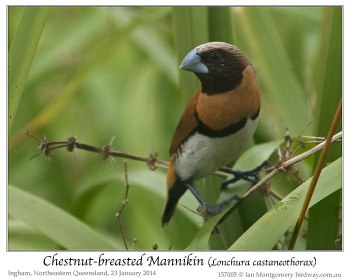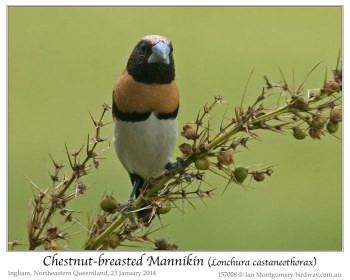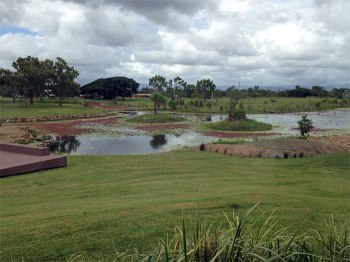Ian’s Bird of the Week – Chestnut-breasted Mannikin/Munia ~ by Ian Montgomery
Newsletter ~ 1-23-14
Please accept my apologies that it is over a month since the last bird of the week. I seem to have been distracted by Christmas, New Year, etc.
Anyway, here is a spontaneous one. I’m in the public library in Ingham at the moment getting my car serviced. I was planning to work on the book Where to Find Birds in Northeast Queensland, but had a nagging feeling that I should really do the bird of the week. I found a table at the back of the library with a pleasant view over the adjacent Tyto Wetlands and spotted 3 Chestnut-breasted Mannikins feeding on the ornamental grass seeds just outside the window.
I had my camera with me and got a couple of photos of one before they noticed me (second photo) and flew away. The photos are a bit cloudy having been taken through glass, but it was good quality plate glass. Members of the genus Lonchura are usually called Mannikins in Australia but they also occur in Asia where the name Munia is used.
This incidentally, is the view of Tyto Wetlands from the library. The dark speck on the lawn in the foreground on the left hand side is the bird in the first two photos.
Tyto Wetlands gets its name from the Barn Owl genus Tyto as it is a known haunt of the elusive Eastern Grass Owl Tyto longimembris which nest sometimes in the grassy area between the wetlands and the local airstrip. I have seen them here on a number of occasions and they have been reported here quite recently, but no photos unfortunately yet.
Ingham is quite a small sugar-cane town so it is greatly to their credit that they, under the guidance and encouragement of John Young of recent Night Parrot fame, have created this wonderful wetland and sanctuary. There is also a large wetland centre near the highway, well worth a visit if you are passing this way.
Now back to the book. I finished the bird section and am now taking photos of as many as possible of the locations and that quest has taken me to some interesting spots that I’ve never visited before.
Best wishes
Ian
Ian Montgomery, Birdway Pty Ltd,
454 Forestry Road, Bluewater, Qld 4818
Phone: 0411 602 737 +61-411 602 737
Preferred Email: ian@birdway.com.au
Bird Photos http://www.birdway.com.au/
Recorder Society http://www.nqrs.org.au
Lee’s Addition:
Then adorn yourself with majesty and splendor, And array yourself with glory and beauty. (Job 40:10 NKJV)
Sounds like you were as busy as the rest of us. What a beautiful bird. I love the clean lines where the colors change. Another neat creation.
Munia and Mannikins belong to two different families. This Chestnut-breasted Mannikin is actually one of the 151 species in the Estrildidae – Waxbills, Munias & Allies Family. There is a family with Manakins that can confuse someone because of the close spelling. (Mannikin vs Manakin) The Pipridae – Manakins Family has 52 species in their family.
See:
Ian’s Estrildidae Family Photos
Ian’s Bird of the Week – Yellow-rumped Munia/Mannikin
Estrildidae – Waxbills, Munias & Allies Family
Pipridae – Manakins Family
*



Hey Ian, I know what you mean about how birding can take you to places that you might not have visited otherwise, and those places being well worth visiting . . . . there are a lot of memorable hikes and trips I have taken (other with family and friends), to see birds — most recently the migratory snow geese at Hagerman National Wildlife Refuge (just west of Sherman, Texas) with one of my grandsons — more than a thousand in sight, not to mention the many American Coots and Northern Shovelers in the many ponds and drainage ditches there. Winter crops are planted there, so the winter migrants are accustomed to staying there for weeks (or months). The refuge is on a southern stretch of Lake Texoma, which itself is a bulge in the Red River that separates Oklahoma form Texas. So if you are passing through that area in the winter you might look at the wildlife refuge’s website before you plan out your trip.
LikeLike
Thanks for the comment, Jim. I have sent a note off to Ian to let him know about your comment.
LikeLike